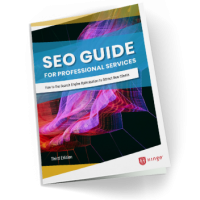The pandemic struck. Shutdown orders were issued. We all had to work from home.
And just like that, all firms conducted their business online. Now you need to make it easy for remote buyers to find you. Our research has shown, again and again, that implementing search engine optimization (SEO) is one of the most effective ways to draw website visitors and build an audience. Yet it’s also the least understood, most underutilized, and most abused of all digital marketing techniques.
- What is SEO?
- What are the two parts of SEO?
- What is earned media?
- What is digital PR?
- Why are digital PR and earned media crucial to SEO?
- What earned media strategies will give your search engine rankings a boost?
What is SEO?
SEO is the practice of drawing more visitors to your website by moving up the search engine results pages (SERPs). This means when your target audience does a web search on Google, Bing, Duckduckgo, or any other search engine, your webpage will be listed at or near the top of the search results. For example, if you’re an expert in operationalizing diversity, equity, and inclusion, an effective SEO strategy will help you appear on the first, if not one of the first few, results pages each time your target audience searches on “how to implement diversity, equity, and inclusion,” “best practices in DEI,” or “how to promote DEI in the workplace.”
I love some of the things I see from digital pr, it’s a shame it often gets bucketed with the spammy kind of link building. It’s just as critical as tech SEO, probably more so in many cases.” — John Mueller, Google
SEO consists of two parts: on-page SEO and off-page SEO.
What is on-page SEO?
On-page SEO refers to creating content and optimizing web pages so that search engines will associate your content with your target audience’s search phrases and rank it as one of the most relevant. Most people associate SEO with on-page SEO. While important, you also need third-party websites and platforms to corroborate your expertise, authority, and trustworthiness (EAT). This is where off-page SEO comes in.
What is off-page SEO?
Off-page SEO are the range of tactics to ratchet up your website’s SEO rankings through the endorsement, expressed or implied, of third parties. Also known as “off-site SEO,” these tactics are implemented online and off. Online, they focus on obtaining backlinks to your website and mentions of your brand on external websites and platforms. Offline they involve, but aren’t exclusive to, mentions of your brand in print, on the radio, and through word of mouth. Online mentions and backlinks signal your authority to search engines. Greater authority translates to higher SEO rankings. Whether online or offline, obtaining this type of third-party credibility is known as earned media.
What is earned media?
Earned media is attention you garner from the public and the media that you haven’t paid for. Before the world wide web, earned media meant unpaid publicity on print, TV, or radio, as well as word of mouth. Since the web’s invention and predominance, the term has included online mentions you haven’t paid for, including:
- Social media mentions or shares of your content (which some call “shared media”)
- Articles you’ve written for online publications
- Articles featuring you, your business, your analysis, opinions, links to your website.
- Online/offline reviews and recommendations
- Search engine results pages (SERPs) where you show up–yes, that’s earned media
…and more
Earned media is no longer just about giving people and firms third-party credibility. With its expansion to the web, it also validates websites.
You can generate earned media through digital PR.
What is Digital PR?
Digital PR is a strategy using digital techniques for obtaining mentions and placements in external websites and platforms to grow your online presence and authority. Far more than link-building in professional services, it’s geared to raise an expert’s profile as a thought leader by tying their brand to the news, trends, and developments in their field. Referred to in some circles as thought leadership PR, it can include pitching your analysis, opinions, and insights to editors looking for guest contributors, journalists needing quotes and soundbites for their stories, research and ranking organizations helping buyers make informed decisions, and podcast hosts on the hunt for guest experts. Reading further you’ll learn that your key relationships in thought leadership PR aren’t limited to those with editors, journalists, and bloggers. They include other thought leaders.
See also: The Visible Expert®: How Ordinary Professionals Become Thought Leaders
What are examples of Digital PR?
Referred to in some circles as thought leadership PR, it can include pitching your analysis, opinions, and insights to editors looking for guest contributors, journalists needing quotes and soundbites for their stories, research and ranking organizations helping buyers make informed decisions, and podcast hosts on the hunt for guest experts. Reading further you’ll learn that your key relationships in thought leadership PR aren’t limited to those with editors, journalists, and bloggers. They include other thought leaders.
Why are Digital PR and Earned Media Crucial for SEO?
Off-page SEO as a search engine ranking factor is more important than most people think. Google’s John Mueller recently said, “I love some of the things I see from digital pr, it’s a shame it often gets bucketed with the spammy kind of link building. It’s just as critical as tech SEO, probably more so in many cases.” Moz’s Search Engine Ranking Factors study corroborates digital PR’s importance: “Off-site SEO-related factors likely carry more than 50% of the [Google] ranking factor weight.”
When online reviews, articles, and social media shares mention you, link back to your site, or both, they can signal to search engines a vote of confidence in your EAT, prompting the virtuous cycle of pushing you up the SERPs, channeling even more traffic to your website, which raises you higher up the SERPs. Note that even linkless positive brand mentions–also known as “implied links”– count towards EAT.
If appearances in other websites and social media platforms can establish your thought leadership, why not beef up your LinkedIn profile rather than invest time and resources in a website? You can’t build authority without first establishing relevance online. Journalists, bloggers, and event producers look up an expert’s thought leadership trail and audience reach. Having a website where you regularly blog and share your ideas and insights is the perfect place to establish that trail and grow an audience. This is how owned media becomes the engine that drives earned media.
7 effective earned media strategies to boost SEO rankings
There are quite a few earned media strategies businesses can use to boost their rankings. But, for the purpose of building credibility as a thought leader through third parties, the following are the most effective.
Strategy #1: Bolster your website with good content
Helpful, keyword-enriched content that dives into the what’s, why’s and how’s of topics enjoy more views, shares, and links. They also draw the attention of journalists and editors.
Example of earned media through owned media:
When Environmental Health & Engineering, Inc. (EH&E) published an insightful, optimized blog article on pandemic commissioning, it drew many views, including that of the editor of a global industry association, who requested that the authors contribute a guest article on the same topic.
Strategy #2: Share your insights with the media
More often than not, the media won’t come to you. You’ll need to reach out and convince them you’re a worthy source or contributor.
One way to share your insights is through guest blogging.
What is guest blogging?
Guest blogging is the practice of writing one or more guest articles for an online publication or another organization’s website. Also known as guest posting, it shows search engines and your audience that you’ve won the confidence of your industry’s trusted sources of information. You can learn more about getting media placements in the article on strategies for improving your SEO with guest blogging.
Moreover, guest blogging can help you rank higher for very competitive keywords if you contribute to an article for a publication with a higher domain authority than your own website.
Example of earned media through guest blogging:
Lee Frederiksen is a regular contributor to Accounting Today and AccountingWeb. Karl Feldman often contributes to Construction Executive and Elizabeth Harr to Washington Technology. These publications have long histories and large audiences. By writing articles for high-profile industry publications like these, Hinge’s visible experts are able target higher volume, extremely competitive keywords, and reach into a more expansive audience.
Not everyone has time to write an article, least of all experts who frequently blog. The less time-consuming option is to send journalists timely, insightful soundbites they can include in articles they’re already working on or plan to. We call this technique “newsjacking.”
What is newsjacking?
The term newsjacking describes the process of commenting on breaking news for publicity. Newsjacking can be particularly efficient, as it offers the chance for multiple journalists to pick up your comment.
Newsjacking is simple, but requires some prep work to get started.
How to newsjack
There are four steps to newsjacking. First, set up an alert for breaking news related to your area of expertise. If you’re an expert in infection control, you’ll want to set up an alert for infection control. Alerts will serve two purposes: notify you when news on your topic hits the headlines, and help you track which journalists are writing about it.
Second, write out your key messages ahead of time. Questions to ask yourself are:
- What’s my angle on this topic?
- Why is it newsworthy?
- How is my angle different and better than what they’ll likely receive from someone else?
- What soundbites can I use to make my point?
- What stats, infographics, and images can I share to make my point?
Third, edit your comments down to 200 words or less. And fourth, when the news breaks, send your comments to the journalists you’ve been tracking.
Example of earned media through newsjacking:
A cybersecurity firm’s website traffic soared when its experts ramped up delivering comments to journalists whose beat covered cybersecurity and journalists who were looking for cybersecurity sources to answer their questions for a story they were writing. By proactively sending comments to both groups of journalists the firms experts increased their media pickups to an average of three per week, leading to more online brand mentions and backlinks, which in turn ushered more traffic to their website.
Strategy #3: Speaking engagements
Our study on Visible Experts® (VEs) shows that speaking engagements are the best way to grow an expert’s reputation, because events are one of the channels buyers frequently use to find the experts they need.
Here’s how speaking engagements impact your SEO. First, submissions require a URL of your organization (another reason why you need a website) and content that shows proof of your expertise (a boon for your blog and external publications). Every time event producers review your submission, they visit your site, review your content, and browse any externally published work. Second, once you’ve been picked as a speaker, the event promotions will mention your name and firm, perhaps link back to your site, and provide a topic description that reinforces your EAT. Third, at the event itself and afterwards, those who’ve attended, -or couldn’t make it to -your session, will likely visit your website and read your blog and resources. Fourth, those same people will probably talk about you and trigger even more website visits. Fifth, journalists you’ve engaged at the event might include you in an article, which they and their readers will share on social media. These are just a few of the many ways events can expand your audience reach.
Example of earned media through speaking engagements:
A/E/C firm Schnackel Engineers improved brand awareness and website traffic by pitching their experts to various podcasts and events. They were featured in the BD+C podcast The Weekly and were accepted to speak at the AGC IT Conference and the ENR Conference. In addition to these speaking engagements, they published articles in FMJ and Facilities.net.
Strategy #4: Social media mentions
When people like your content, they’ll share it with their networks. Besides links to articles, people like to share infographics and intriguing statistics accompanied with a concise, easy-to-absorb explanation.
But there’s more to social media as a multi-use phenomenon–it’s another channel for commenting meaningfully on your topics.
Examples of earned media through social media mentions:
Remember that list of journalists you’re tracking for newsjacking? If you follow them on social media, you can share their article along with your expert commentary. On LinkedIn, you can tag them and their networks will gain visibility of your expert comments, which readers will share if your posts help them feel like they’re “in the know” of something valuable.
Strategy #5: Referrals and recommendations
Referrals and recommendations, the most popular marketing techniques used by VEs, are considered the third most impactful, after writing books and speaking engagements. Although these referrals and recommendations aren’t always online, they invariably result in more website traffic.
Strategy #6: Work with influencers
Who are the recognized individuals and organizations in your industry? What relationships have you built with them? Our research on VEs underscore the importance of nurturing those relationships. Almost one in five experts (17.2%) report that other VEs bring them new business opportunities, help advance their reputations (16.2%), and provide introductions to other VEs (also 16.2%).
They can also share their audience with you. Many VEs are regular bloggers, and a growing number host their own podcast. And no matter how they keep their audience engaged, you can always fill gaps in their content. A guest appearance or a guest article can give your reputation and your website’s reputation with search engines a nice bump.
Example of earned media through work with influencers:
Hinge has published a book titled The Visible Expert. The book details the careers and techniques of thought leaders within the professional services. By engaging in mutually beneficial book promotions with these industry experts, Hinge helps expand the experts’ audience reach as much as they’re able to expand Hinge’s.
Strategy #7: Partnership marketing
Partnership marketing is the practice of collaborating with another firm that targets your audience but offers services that complement or minimally overlap with yours. Think of it as a way to close any gaps in your content while building visibility and profitability. Any time you collaborate on, say, a book on a signature topic, co-host a webinar, conduct research, or exchange blogs, yours and your partner’s promotions will generate publicity and shepherd more visitors to your site. This is the reason partnerships are one of the top five digital strategies of high growth firms.
Examples of earned media through partnership marketing:
Writing articles for your partner’s site while publishing your partner’s articles on your website is one of the quickest ways to satisfy your partner’s and your need for more and better content while reaching each other’s audience. The key is to develop original content that is distinct from any you’ve written for your own website. Otherwise, your guest article could undermine your onsite SEO strategy.
Another example is to co-present at a webinar or in-person event. By drawing on the expertise of two firms rather than just one, collaborative presentations are a great way to develop distinct, original, and more impactful content. By bridging at least two areas of expertise, both firms are able to address issues in unique ways.
The impact of off-page SEO
COVID has turned your buyers into remote buyers, and your website into the most important tool for engaging them. SEO has become one of the most important strategies for firms to survive or thrive in a largely digital marketplace. But as businesses of all stripes flex their SEO muscles, you’ll need to level up by combining robust on-page with off-page SEO strategies. The digital PR and earned media strategies we’ve outlined will help you build on, and complement, the achievements of technical SEO tactics, generate more leads, and win more business.
If you’re still not convinced of the impact of off-page SEO, consider this: When EH&E began to receive more media attention, their website traffic grew four times.
This is how relationships that build reputations drive results.
How Hinge Can Help
Create a website your audience can easily find while growing your reputation as a thought leader. Our High Performance Website Program combined with digital PR outreach will not only generate leads but lay the groundwork for speaking gigs, guest blogs, and mentions that will help establish you as a true thought leader, also known as a Visible Expert.
Additional Resources
To learn more about how on-site and off-site SEO play a role in the success of your marketing, take a look at another blog post, The Power of Integrated Marketing: How Owned, Earned, Paid, and Shared Media Can Drive Visibility in a Zero-Click World
Read the SEO Guide for Professional Services. This updated, easy-to-read guide is written specifically for busy professional services executives. It will give you the foundation you need to begin planning your SEO strategy and start growing your business.






